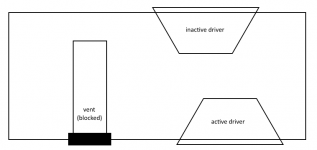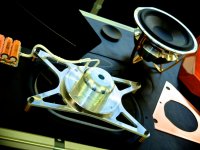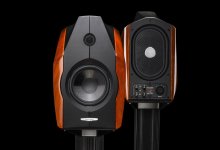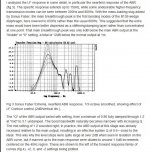I have a 12-inch subwoofer driver mounted in quite a large heavy wooden box, and have experimented with venting but I prefer the sound when there are no vents. However it is a little quieter without a vent. On the other side of the box is another driver, also 12 inches, facing away from the first. This driver is of lower quality and I don't really like the sound it makes. The superior driver is good enough anyway. So what I've done is I've disconnected the lower quality driver, and blocked up the vent. Now what happens is the inactive driver moves with the first, and there is a very small but essentially unnoticeable delay between the first moving and the second moving. When I press against the inactive driver such that it can't move, the volume seems to decrease slightly. Lower notes seem to be played better when I let the inactive driver move. At the moment this setup produces the best sound I can get from my box, but I'm not sure exactly what is happening. I think it may be an effect somewhere halfway between a vented box and a sealed box. I'm wondering if anyone else has experience with this sort of setup or can tell me what's going on, if there is a name for it, or if it seems completely stupid. I've attached a diagram of what my box looks like
Attachments
Its called a passive radiator design, quite common where you need to tune very low in a small box: home theatre.
Yours could be tuned anywhere, though I'd guess >40Hz.
If it was mine, I'd probably remove the inactive driver and keep the sealed cabinet - using a cheap driver as a PR probably isn't a good move: it'll add distortion as its suspension goes nonlinear.
Chris
Yours could be tuned anywhere, though I'd guess >40Hz.
If it was mine, I'd probably remove the inactive driver and keep the sealed cabinet - using a cheap driver as a PR probably isn't a good move: it'll add distortion as its suspension goes nonlinear.
Chris
Tunable passive radiator challenge
LOL I’m afraid that you will think that I am putting you on, but here goes:
I THINK it was Sonus Faber that did something very unique. In their Extrema, they used a full KEF oval woofer in the rear, but it was not hooked up to any amplifier. They used different sized capacitors and maybe one other component (resistor?) and with a selector knob you could control the loading of the radiator, by varying the capacitance. IOW, it was a full fledged woofer that was not hooked up to the amp. The caps, and maybe a resistor, were selected to go across the terminals for your choice of bass roll off. Sorry to not be so sure of some of this stuff. I believe that in thiele small parameters that capacitance = mass, and that is why it worked so well. Back in the day, I tried it, with two 12’s, one live and one dead, and it worked like a charm!
Just a thought, but if you have some caps laying around give it a try just to experiment. I believe I used between 200-400 uF electrolytics.
The Challenge: I bet there are plenty of people here who may not have even heard of this, but can figure out the details.

LOL I’m afraid that you will think that I am putting you on, but here goes:
I THINK it was Sonus Faber that did something very unique. In their Extrema, they used a full KEF oval woofer in the rear, but it was not hooked up to any amplifier. They used different sized capacitors and maybe one other component (resistor?) and with a selector knob you could control the loading of the radiator, by varying the capacitance. IOW, it was a full fledged woofer that was not hooked up to the amp. The caps, and maybe a resistor, were selected to go across the terminals for your choice of bass roll off. Sorry to not be so sure of some of this stuff. I believe that in thiele small parameters that capacitance = mass, and that is why it worked so well. Back in the day, I tried it, with two 12’s, one live and one dead, and it worked like a charm!
Just a thought, but if you have some caps laying around give it a try just to experiment. I believe I used between 200-400 uF electrolytics.
The Challenge: I bet there are plenty of people here who may not have even heard of this, but can figure out the details.
Hi,
The guys are spot on, the driver w/o a connection works like a passive radiator, and should work better w/ the port tube close. It would work best if the moving mass in the passive radiator is increased to provide proper tuning to the system. At the correct tuning point the twin impedance peaks below and above the driver resonance should be about even.
As pointed out by DaveThreshold the Sonus Faber Extrema used this system w/ resistors to be able to adjust the system Q. I don't think they used any capacitors in the ABR (auxiliary bass radiator) circuit, only resistors. I found some pictures of the Extrema ABR.
Regards,
The guys are spot on, the driver w/o a connection works like a passive radiator, and should work better w/ the port tube close. It would work best if the moving mass in the passive radiator is increased to provide proper tuning to the system. At the correct tuning point the twin impedance peaks below and above the driver resonance should be about even.
As pointed out by DaveThreshold the Sonus Faber Extrema used this system w/ resistors to be able to adjust the system Q. I don't think they used any capacitors in the ABR (auxiliary bass radiator) circuit, only resistors. I found some pictures of the Extrema ABR.
Regards,
Attachments
Last edited:
Hi,
The guys are spot on, the driver w/o a connection works like a passive radiator, and should work better w/ the port tube close. It would work best if the moving mass in the passive radiator is increased to provide proper tuning to the system. At the correct tuning point the twin impedance peaks below and above the driver resonance should be about even.
As pointed out by DaveThreshold the Sonus Faber Extrema used this system w/ resistors to be able to adjust the system Q. I don't think they used any capacitors in the ABR (auxiliary bass radiator) circuit, only resistors. I found some pictures of the Extrema ABR.
Regards,
Hi,
No capacitors are involved. A normal driver used as as a PR
can have various resistances across it to vary the damping.
rgds, sreten.
Oh, O.K. Thanks you two. That is a FANTASTIC book which I read about 8 times. I have a much older version, so that may not be in there. Faber came up with a lot of clever stuff.
- Status
- This old topic is closed. If you want to reopen this topic, contact a moderator using the "Report Post" button.




